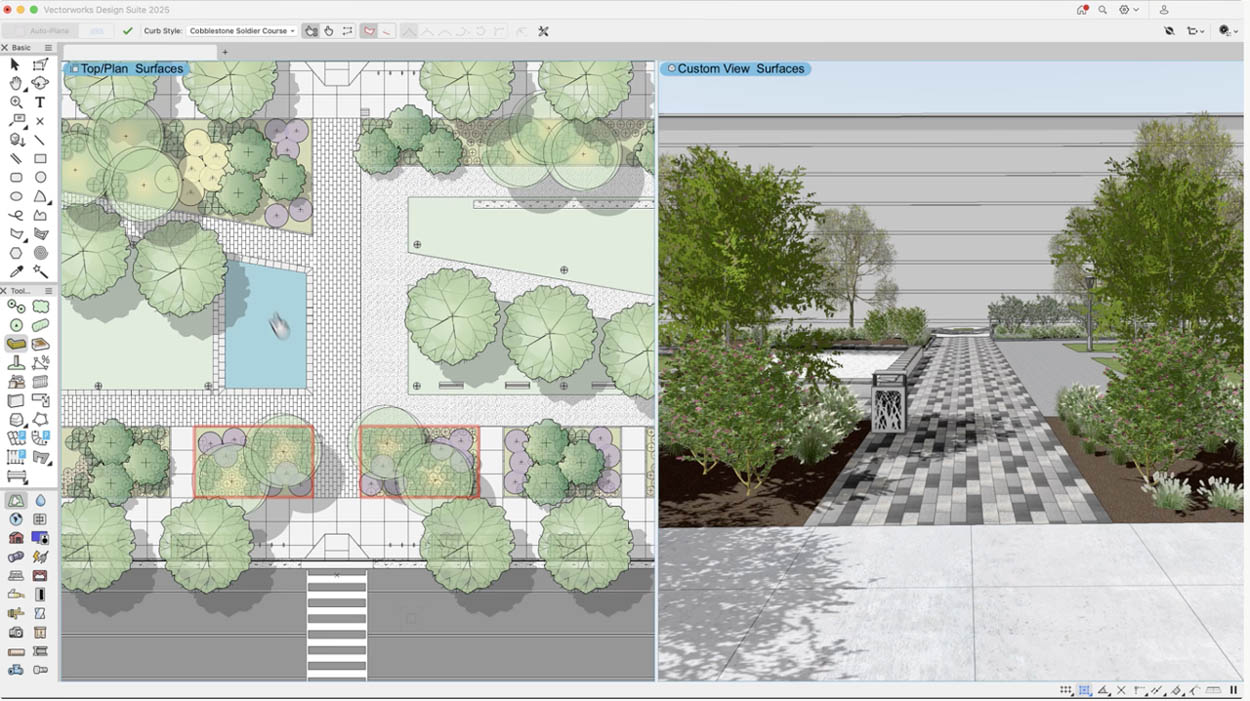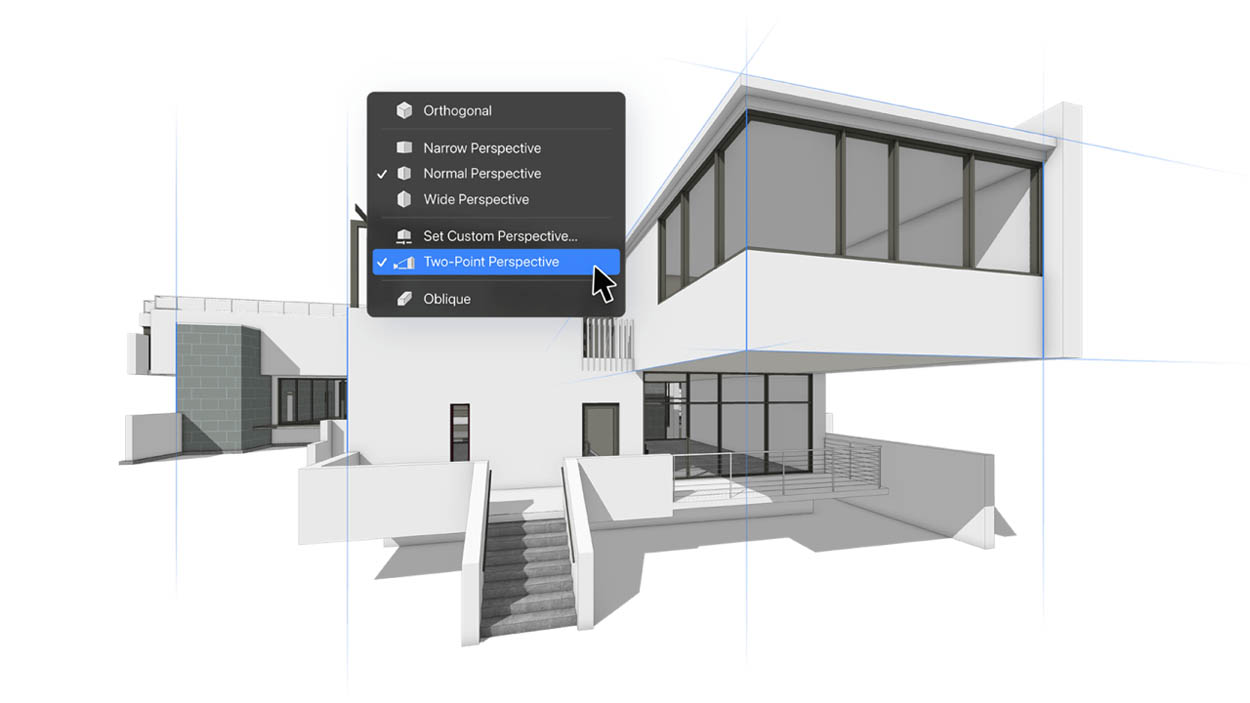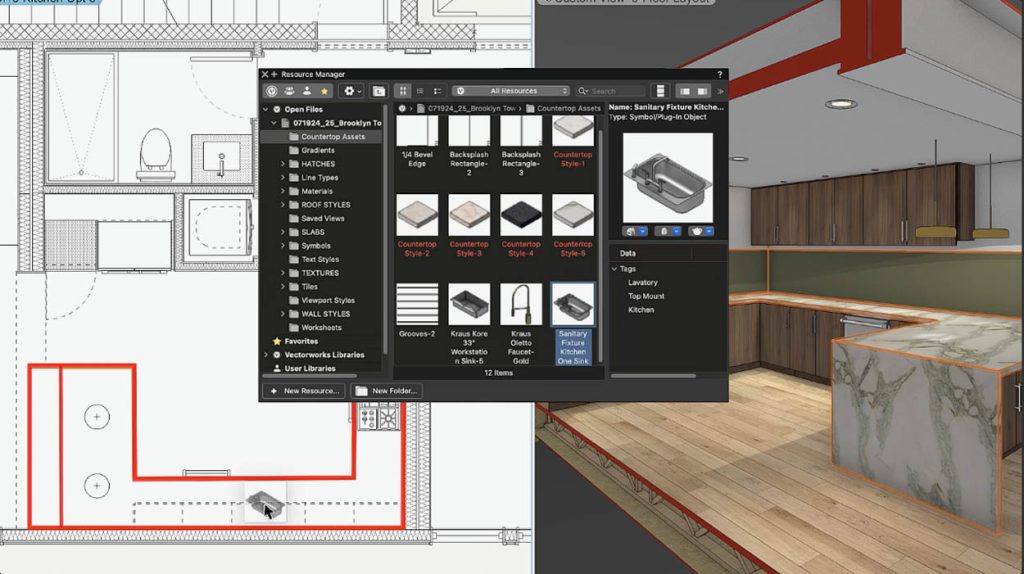For the 2025 release of Vectorworks, we caught up with company CEO, Biplab Sarkar, to talk new features, moving from file to cloud databases, auto-drawings AR, openness in BIM and, of course, AI
AEC Magazine: How would you define the overarching theme for the 2025 release? (there seem to be a lot of features aimed at simplification of tasks)
Biplab Sarkar: Vectorworks 2025 unleashes a new world of visual understanding and communication for designers. This latest release introduces new workflows and tools that empower designers to bring their visions to life easily, saving time and enhancing efficiency throughout every design phase. Top features like Onscreen View Control provide easy, instant access to all views of a model, along with a click-dragging functionality that simplifies the process of orbiting models, making design adjustments more fluid and intuitive. The Two-Point Perspective feature allows users to create traditional architectural compositions and professional photography perspectives with a single click. Additionally, the Object Level Visibility feature gives users the power to manage the visibility of specific objects within a design, offering options to show, ghost, hide, or isolate individual objects, thus providing greater control over complex projects. The Vectorworks Cloud Document Reviewer further enhances collaboration by allowing customers to view and comment on documents from anywhere, streamlining the review and design process.

Overall, Vectorworks 2025 redefines the design software experience by simplifying tasks and fostering better collaboration. While tasks are simplified, this release also adds significant depth to existing functionality, such as the management of room finishes and countertops, as well as to new features like persistent Two-Point Perspective and data visualisation that supports object visibility. These enhancements enable designers to work more efficiently and creatively in a way that truly mirrors their needs and expectations.
AEC Magazine: Collaboration comes in for a major update, easing working with Revit data, DWG/ DXF and project share capabilities. Could you outline these advances?
Biplab Sarkar: Vectorworks 2025 includes improved Revit and DXF/DWG collaboration. With these improvements, users can conveniently process Revit file exports in Vectorworks Cloud, including support for older Revit formats, without interrupting their workflow. Additionally, you can save time with continuously high-quality DXF/DWG collaboration, offering detailed and flexible control of incoming and outgoing file structure and graphics to achieve accurate delivery the first time.
Project Sharing enhancements allow for better convenience and efficiency. With direct setup options, you can choose whether to use cloud-, network-, or server-based sharing and begin your work. Shared project files can be worked on and stored on any cloud service, and backups are automatically saved as offline files.
These collaboration advances enhance the overall efficiency of working within multidisciplinary teams, supporting a more integrated and cohesive design process, saving time, and improving project outcomes.
AEC Magazine: The AEC industry is still working in traditional file-based workflows, but there are now moves to cloudbased granular workflows. Could you enlighten us on how you think this could be done better / when we can expect to see something from Vectorworks?
Biplab Sarkar: The shift from traditional file-based workflows to cloud-based granular workflows is a pivotal change in the design industry. It is driven by the need for real-time collaboration, better data accessibility, and streamlined project management across teams.
Vectorworks embraces this transition by developing advanced cloud-based solutions that facilitate more interconnected and accessible project environments. Enhancing these workflows involves enabling real-time, multi-user collaboration with instant updates, implementing granular access controls for secure role-based interactions, and ensuring seamless integration with existing tools and processes.
Many BIM platforms promote openness but can still restrict data exchange and favour their own ecosystems, leading to partial interoperability
We are already making strides with cloud offerings, such as Vectorworks Cloud Services, the Vectorworks Nomad mobile app, and the newly released Cloud Document Reviewer, which lay the groundwork for more robust cloud capabilities. We have also been focused on processing different file formats in Vectorworks Cloud Services. In Vectorworks 2025, we introduced the ability to process all RVT exports via Vectorworks Cloud Services. We will be working to expand this capability to other file formats such as DWG, IFC, USD, etc. Supporting file formats for both import and export will lay the foundation for a cloud-based collaboration workflow.
As cloud adoption grows, users can expect Vectorworks to expand its cloud capabilities further, providing comprehensive solutions that enable more granular, accessible, and collaborative workflows.
Find this article plus many more in the Sept / Oct 2024 Edition of AEC Magazine
👉 Subscribe FREE here 👈
AEC Magazine: There’s a lot of talk about auto-drawings, with firms like Graphisoft, Graebert, Autodesk, Bentley and SWAPP all now trying to apply AI to deliver productivity enhancements. Is Vectorworks looking at this area and what other applications of AI can users expect to see?
Biplab Sarkar: We are keenly aware of the growing interest and advancements in auto drawings and the application of AI to enhance productivity within the design and construction industries. We are actively exploring this area and evaluating how AI-driven technologies can be integrated into our software to streamline workflows and improve efficiency. The potential of AI to automate drawing tasks, predict design outcomes, and facilitate more intuitive interactions holds great promise for enhancing our users’ experience.
In addition to the AI Visualizer, we are looking to expand AI capabilities in our software to allow users to search Vectorworks learning resources using natural language for faster support.

AEC Magazine: There has recently been an uptick in the promotion of Vectorworks Landmark. it’s an area in which Vectorworks has little specialised competition. As Vectorworks expands collaboration capabilities with other BIM tools like Revit, how is landscape industry adoption changing and what capabilities enable this?
Biplab Sarkar: Vectorworks Landmark is uniquely positioned in the industry as the preferred BIM solution for landscape architecture and design professionals. Specifically created for landscape professionals, Landmark’s adoption is growing as Vectorworks expands its collaboration capabilities with other BIM tools like Revit. Landmark’s robust site planning, terrain modeling, and planting design tools allow landscape professionals to seamlessly manage complex 2D and 3D workflows from pre-design to documentation, enhancing their participation in multidisciplinary BIM projects.

Key capabilities driving this adoption include enhanced interoperability through IFC support, direct file exchange, and referencing with Revit, facilitating smoother collaboration with architects and engineers. Landmark 2025 introduces a precise 3D tool for curbs, edging, and borders and the Survey Point tool to cater specifically to landscape needs. We’re also expanding on our sustainable site design offerings with new permeability and sustainability settings for objects like the hardscape and landscape areas. As Landmark continues to integrate with other BIM platforms, its specialized tools and streamlined workflows make it increasingly attractive to landscape professionals looking to enhance their role in collaborative design projects.
AEC Magazine: Cloud is an increasingly important platform, especially for collaboration. With many start-ups now promoting the Figma pure-cloud play (in browser or thin client), how do you see the future of desktop applications and are there advantages to desktop apps vs cloud-based ones?
Biplab Sarkar: As cloud technology continues to evolve, its role in fostering collaboration and enabling remote work has become increasingly significant. The rise of cloud-based platforms, such as Figma, underscores the growing preference for flexible and accessible solutions. However, the future of desktop applications remains relevant and valuable. Desktop applications offer certain advantages that cloud-based solutions may only partially replicate. They often provide more robust performance, enhanced security, and the ability to work offline, which can be crucial for users in environments with limited or unreliable internet access.
Desktop apps also typically offer more comprehensive features and customisations that can be tailored to specific workflows and user preferences.
In the coming years, a hybrid approach will likely become the norm, where the strengths of both desktop and cloud-based applications are leveraged to meet diverse user needs. This approach allows cloud collaboration flexibility while retaining desktop software’s robust capabilities and offline reliability. Integrating both platforms will enable users to benefit from a seamless and efficient workflow that maximises productivity and collaboration.
AEC Magazine: AI and ML promises much but needs to be trained. In developing these tools, what kind of data will you train on? Customer data obviously has IP issues, as well as possibility of errors. Do you think there will be generic AI and ML tools, individual customercentric AIs, or both?
Biplab Sarkar: We envision a dual approach regarding the future of AI and ML in our field. On the one hand, generic AI and ML tools will provide broad capabilities applicable across various use cases, offering solutions that can be widely implemented and adapted. On the other hand, we recognise the value of developing customer-centric AI solutions tailored to individual clients’ unique needs and challenges. Additionally, with customer consent, Vectorworks can leverage anonymous session log files containing usage data to predict customer usage patterns, enabling a predictive design system. By balancing both generic and bespoke AI tools, we aim to deliver comprehensive and practical solutions catering to diverse requirements, ultimately enhancing overall user experience and satisfaction.
AEC Magazine: Vectorworks has been very advanced in working with intelligent reality capture tools, like Apple’s AR Toolkit. How well do you think adoption of this technology has gone and where do you think it will be going with rapidly evolving ‘meta’ tookits?
Biplab Sarkar: Vectorworks has been at the forefront of integrating advanced reality capture tools, including Apple’s AR Toolkit. Our commitment to leveraging these technologies has enhanced how our users interact with and visualise their projects.
The adoption of these tools has been quite promising. They have significantly improved data capture and integration accuracy and efficiency, providing our users with more immersive and precise project experiences. As a result, we’ve seen more professionals embracing AR to streamline workflows and make more informed design decisions.
The evolution of ‘meta’ toolkits and augmented reality technologies presents exciting opportunities. These technologies will transform how projects are conceptualized, designed, and executed as they advance. Integrating advanced AR capabilities with BIM and other intelligent technologies, along with support for platforms like Nvidia Omniverse, will likely lead to even greater levels of interaction and visualisation, driving innovation in the AEC industries.

AEC Magazine: Openness is something that is talked about a lot today. With your extensive experience in the market, on a technology level, are today’s leading BIM developers truly open with their data, toolkits and APIs? The days of reverse engineering file formats may be coming to an end, but will we have interoperability without dumbing data down to lowest common denominator industry formats?
Biplab Sarkar: Despite progress toward better data exchange and interoperability, openness remains a significant challenge in the industry. Although industry standards like IFC and BCF are becoming more common, achieving seamless integration with compromising data quality remains challenging.
Many BIM platforms promote openness but can still restrict data exchange and favour their own ecosystems, leading to partial interoperability. This often results in data being simplified to the lowest common denominator, which can reduce the richness and detail of the information shared across platforms. For true interoperability, developers must fully embrace open data standards and interoperable APIs, allowing for more accurate and integrated workflows without losing critical data. The industry must move towards this level of openness to enable more efficient and effective multi-platform collaboration.
Vectorworks supports international openBIM standards, enabling seamless collaboration across BIM software products. It has been certified by buildingSMART International (bSI) for its IFC4 import capabilities, ensuring high-quality IFC models for accurate and credible work throughout the project lifecycle. This is crucial for multi-disciplinary projects using different software tools, as Vectorworks maintains data exchange standards, reducing errors and misunderstandings.






